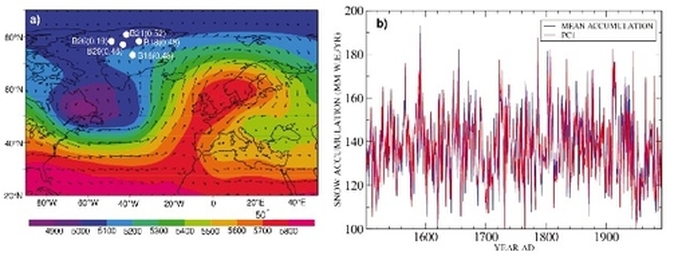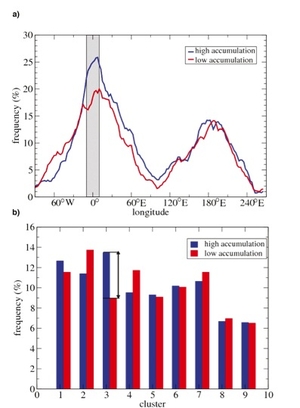Northern hemisphere atmospheric blocking in ice core accumulation records from northern Greenland
Atmospheric blocking is a large-scale, mid-latitude atmospheric phenomenon often associated with persistent quasi-stationary, synoptic-scale, high-pressure systems. The formation, maintenance and collapse of atmospheric blocking cause large-scale circulation anomalies and strongly impact weather patterns. Therefore, blocking regimes constitute a significant climatological feature.
Northern hemisphere blocking shows important variability at different time-scales. Blocking frequencies have shown a downward (upward) trend over Atlantic and European (west Pacific) sectors. Superimposed on these linear trends, blocking frequencies show significant interannual and decadal variation (Barriopedro et al., 2006). However, in these studies, the blocking variability was derived over the relatively short time period covered by observational data with daily resolution. Here, we present the first attempt to directly relate interannual and decadal variability of several high-resolution snow accumulation records from northern Greenland with northern hemisphere atmospheric blocking. First, we investigate the relationship between atmospheric blocking and accumulation variability during the period covered by both accumulation and high-resolution (daily) observational data. Based on this relationship, we then discuss the blocking variability over the last 400 yr based only on the accumulation variability.
As an example of blocking circulation, we present in Figure 1a the 500-hPa geopotential height (shaded) and horizontal wind (vectors) during the mature phase (3 February 1975) of the blocking event that occurred in the North Atlantic sector from 28 January to 9 February 1975 (Diao et al., 2006). It can be seen that large-scale westerly flow, which is strongly blocked over the northeast Atlantic, influences the Greenland region.
The Alfred Wegener Institute for Polar and Marine Research (AWI) in Bremerhaven, Germany performed a North Greenland Traverse (NGT) between 1993 and 1995 (Schwager, 2000). As a proxy for the blocking variability, we analyzed the yearly snow accumulation time series from five ice cores drilled during the NGT (Fig. 1a): B16 (73.9°N, 37.6°W; Miller and Schwager, 2004), B18 (76.6°N, 36.4°W; Miller and Schwager, 2000a), B21 (80.4°N, 41.1°W; Miller and Schwager, 2000b), B26 (77.3°N, 49.2°W; Miller and Schwager, 2000c) and B29 (76.0°N, 43.5°W; Miller and Schwager, 2000d). These shallow ice cores reach depths up to 150 m. Mean accumulation rates vary between 104 and 179 mm water equivalent/yr. The period covered by all five annual resolution records is 1502 to 1992 (or 491 years). These accumulation records are available through the PANGAEA online environmental database (www.pangaea.de).Accumulation records from Greenland are affected by both meteorological and glaciological noise (CruÌger et al., 2004). To filter out this noise and to obtain the dominant patterns of accumulation variability, an Empirical Orthogonal Function (EOF) is applied to normalized accumulation anomalies over the entire 1502 to 1992 period. The first EOF (Fig. 1a), which describes about 24% of variance, captures in-phase variability of all accumulation records. Its associated time coefficients (PC1) show variations very similar to the mean accumulation of the five records (Fig. 1b).Since blocking heights affect the middle and upper troposphere, the 500 hPa geopotential anomaly field is widely used to identify blocking events. A popular algorithm to identify blocking events in this field, also used in our study, was developed by Tibaldi and Molteni (1990). For each longitude, the northern (southern) meridional 500 hPa geopotential height gradients are calculated between three base latitudes, 55°N, 60°N and 65°N and the corresponding 20°N (S) latitudes. A given longitude is defined as blocked at a specific instant in time if at least one gradient between the base and southern latitudes is greater than zero, and at least one gradient between northern latitudes and the corresponding basic latitudes is smaller than -10 m/degree latitude (Tibaldi and Molteni, 1990). The frequency of blocking (with neither time persistence or spatial criteria yet imposed) at a certain longitude is defined as the ratio between the number of days when that longitude was blocked to the total number of days of the analyzed period.The frequency of blocking events during high accumulation years (PC1 higher than 0.75 standard deviation) is significantly higher in the Atlantic-European sector (20°W-100°E) than the corresponding frequency during low accumulation years (PC1 lower than -0.75 standard deviation). A reverse situation is found for the sector 80°W-20°W (Fig. 2a). No significant differences between the frequencies of blocking events during high and low accumulation years were detected outside the Atlantic and European sectors (Rimbu et al., 2007). A cluster analysis of a daily-reconstructed atmospheric circulation since 1850 revealed that winter atmospheric circulation in the Atlantic-European region is optimally represented by 9 clusters (Philipp et al., 2007).
To better assess the relationship between the snow accumulation variability on Greenland and Atlantic-European atmospheric circulation, we compared the frequency of these clusters during high and low accumulation years for the period 1850-1992 (Fig. 2b). Significantly higher frequency of cluster 3 is recorded during high relative to low accumulation years. Cluster 3 represents a blocking high centered near the UK (Philipp et al., 2007).A blocking-like circulation is associated with a blocking event if it is persistent in time and extends over several longitudes. The typical duration of blocking episodes varies between 5 and 30 days (Tibaldi and Molteni, 1990). Based on the frequency distribution of blocking-like circulation states, as represented in Figure 2a, we define a blocking index as the number of days in a winter when in sector 5°W-5°E (Fig. 2a, shaded region) at least three consecutive longitudes are blocked for at least four consecutive days. The blocking index is significantly correlated with accumulation PC1 over the period 1948-1992. This result is confirmed by a composite analysis. It reveals that this sector was blocked on average 13.6 days per winter during high accumulation years, which is significantly more frequent than the 8.6 days per winter during low accumulation years.To identify the physical mechanism responsible for the relationship between blocking activity and the dominant pattern of accumulation variability, we investigated the moisture transport (Peixoto and Oort, 1992) in the Atlantic European region during years characterized by high and low values of the above-defined blocking index. The axis of maximum moisture transport, defined as vertically integrated water vapor transport (vectors), shifts to a more northeast-directed orientation across the Atlantic and extends northward to Greenland during years of high blocking index values (Fig. 3a) relative to the times of low blocking index (Fig. 3b). A significant reduction in the magnitude of atmospheric moisture transport (contour lines) over Greenland during periods of less frequent blocking relative to periods of frequent blocking is also evident.We have shown that over periods covered by observed and reconstructed daily atmospheric circulation data, high accumulation in our Greenland ice cores is associated with high blocking frequency in the Atlantic-European region. Assuming that this relationship is stable in time, the periods of relatively high (low) accumulation during the last 400 years are characterized by high (low) blocking activity in the Euro-Atlantic region. We detected significant peaks at bi-decadal (~20 yr) and multi-decadal (~70 yr) timescales in the PC1 of accumulation records, which may also characterize the blocking activity in the Atlantic region. Our analysis should be extended to other proxy data, as well as to climate model experiments, for a better understanding of blocking variability during past periods.
(PAGES news, Vol. 16, No. 2. April 2008)
References
- Diao, Y., Li, J. and Luo, D., 2006: A new blocking index and its application: blocking action in the Northern Hemisphere, Journal of Climatology, 19: 4819-4839.
- Philipp, A., Della-Marta, P.M., Wanner, H., Fereday, D.R., Jones, P.D. and Moberg, A., 2007: Long-term variability of daily North Atlantic-European pressure patterns since 1850 classified by simulated annealing clustering, Journal of Climate, 20: 4065-4095.
- Rimbu, N., Lohmann, G. and Grosfeld, K., 2007: Northern Hemisphere atmospheric blocking in ice core accumulation records from northern Greenland, Geophysical Research Letters, 34: L09704, doi:10.1029/2006GL029175.
- Schwager, M., 2000: Ice core analysis on the spatial and temporal variability of temperature and precipitation during the late Holocene in North Greenland, Reports on Polar Research, 362: Alfred Wegener Institute for Polar and Marine Research, Bremerhaven, Germany.
- Tibaldi, S. and Molteni, F., 1990: On the operational predictability of blocking, Tellus series A, 42: 343-365.


